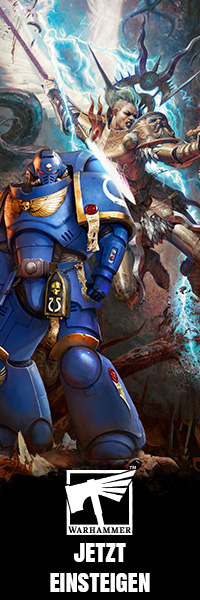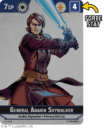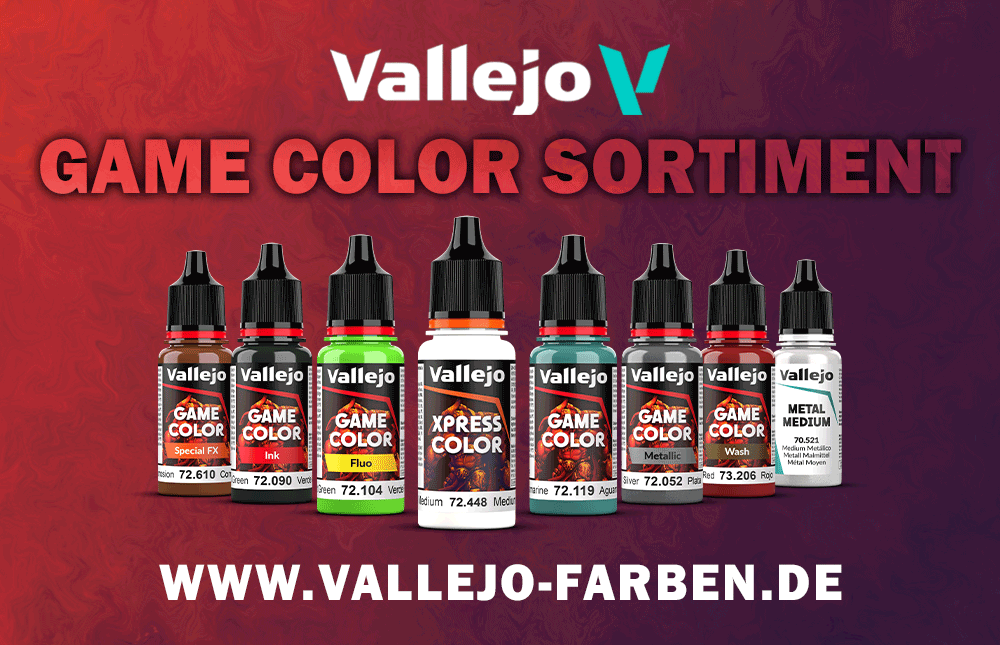Star Wars Shatterpoint: Regelpreviews
Atomic Mass Games hat einen Blick auf die Regeln von Star Wars Shatterpoint geworfen.
Welcome back to the third installment in our Star Wars™: Shatterpoint series. So far, we’ve looked at the all-important aspects of building your strike team and how Missions pit your strike teams against each other to accomplish your objectives. Today we’re going to take a look at some general gameplay concepts including how game turns are structured, how activations and actions work, and how the power of the Force impacts games of Shatterpoint.
So, you’ve built your strike team, set up the Mission, and you’re ready to ignite your lightsabers and start firing away with your blasters. But how exactly do you do that?
The game uses 5 range tools for measuring things like abilities and attacks: 4 range tools numbered 2-5 and a shove tool. Range 1 abilities can be measured using the short end of any of the Range tools or either end of the shove tool. Movement in Shatterpoint uses just two movement tools. The long movement tool is used when a character makes an advance, while the short movement tool is used for a number of different movements like dashing, jumping, and climbing. The use of these tools means that measuring anything in the game is fast and easy.
Like the vast majority of tabletop games, Shatterpoint uses dice to determine the outcome of various actions, most notably attacks. There are two types of dice in Shatterpoint. Attack Dice which are eight-sided and Defense Dice which are six-sided. We’ll be going over the dice and how they are used in far more detail in an upcoming article.
In most tabletop miniatures games, gameplay is divided into a certain number of Rounds, with each Round typically being broken down into phases or turns that dictate how players activate their miniatures and resolve the actions in the game. Shatterpoint breaks from this standard format by removing the concept of Rounds. Instead, games of Shatterpoint are played over a series of alternating player Turns. As we worked on the development of the game, we realized that the dynamic, action focused experience we wanted from the gameplay was hindered by the artificial breakpoint of Rounds. After all, who enjoys commercial breaks cutting away from the show right when the story is getting to its best part?
In the same way, we designed Shatterpoint to keep players constantly in the action from start to game end. Many of the traditional game mechanics that would be handled in the phases of a round have been integrated into the player turn, thereby creating a very smooth game flow and pacing that gets more intense and exciting as the game progresses to its ultimate conclusion.
During a player’s turn, they get the chance to activate one of their Units. When a Unit activates it can make up to two actions. The basic actions in Shatterpoint are:
Move – Each character in the Unit may advance, dash, or climb.
Focus – The next attack made by each character in the Unit this activation adds 1 die to its attack roll
Combat – Each character in the Unit may make an attack
Ability –The Unit may use an ability that requires the use of an action
Recover – Each character in the Unit may Heal. When a character Heals it may remove one Condition or 1 Damage from itself or another allied character within Range 2 of it.
Take Cover – Each character in the Unit is Pushed and gains a Hunker Token which improves its defense against Ranged attacks.
In addition to its standard actions, many characters have unique abilities that they can use during play. We will take a closer look at these abilities and how they function in a future article.
Unit activation works quite a bit differently from any of Atomic Mass Games other games and is purposefully designed once again to help create the experience of the high tension and somewhat tumultuous action of the best Saturday morning animated stories. Shatterpoint’s battles aren’t the carefully planned out, strategic affairs you find in games with large armies duking it out. These are the moments where our heroes and villains have been thoroughly thrown from the expected and now must use their cunning and wits to seize victory and change the course of fate. To bring this feeling to the game, players have very little control over how and when each Unit will activate. Each Unit has its own Order Card. At the start of the game, each player shuffles all their Unit Order Cards together, along with a special Shatterpoint Order Card to create their Order Deck.
At the start of a player’s turn, they draw the top card of their Order Deck. The card drawn determines which Unit the player can activate that turn. The greatest commanders in Shatterpoint will be the ones who learn to adapt quickly to the chaos of battle and make the most of what fate gives them to work with.
However, not everything is completely out of the player’s control. Each player has the option to place a just drawn card in Reserve (for a cost). If a player chooses to place their drawn Order Card in reserve, they immediately draw the next Order Card from the top of their deck and must activate that Unit instead. On future turns a player with a card in reserve may choose to activate that Unit instead of drawing the top card of their Order Deck. A player may only ever have one card in Reserve at a time, so players must choose wisely when to use this ability.
In addition to the Reserve mechanic, players also each have an extremely powerful Shatterpoint card. The Shatterpoint Card acts like a wild card, allowing players to activate the Unit of their choice, even a Unit that has already Activated with its own Order Card previously.
At the end of a player’s turn, if they have no Order Cards left in their Order Deck or reserve, they Refresh their Order deck by removing any Order Cards for defeated Units and then shuffling the remaining cards from the Order Discard Pile together to form a new Order Deck.
Rounding out Part I of our gameplay overview, we need to talk about the Force and how its presence is represented in games of Shatterpoint. In Star Wars, the Force is a powerful ally, and though only certain individuals trained in its use can tap into its full potential, the presence of the Force still has a powerful influence on characters and the world around them.
At the start of the game players determine the Will of the Force by adding Force tokens to their Force pool equal to the combined total of all Force stats on their strike team’s Unit Stat Cards. Typically, only Primary Units have a Force stat, so most often a strike team’s Force pool will be equal to the combined Force stats of its two Primary Units.
Throughout the game players will spend Force to activate their Unit’s abilities and to place Order cards in reserve. It is up to each player to carefully weigh how to use their limited Force pool when activating their Units. Should they spend a majority of it early on a couple of powerful activations? Or should they be more sparing with the Force available to them, letting every Unit potentially use some of their abilities but not all? Smart use of a player’s Force pool will mean the difference between victory and defeat.
That’s all for today’s transmission. Be sure to watch for Part II of our Gameplay Overview where we will be talking about Character Stat Cards! Pre-order your copy of the Star Wars: Shatterpoint Core Set at your local game store or through the webstore today!
Quelle: Atomic Mass Games








Ich finde das schon mal recht ansprechend muss ich gestehen. Die Aktionen sind sinnig. Die Aktivierungsrandomisierung finde ich recht nett gemacht, fand ich als Spannungs-Element schon bei Star Breach gut (nicht weil es dort genauso gelöst wäre sondern weil ich das eine nette zusätzliche ebene finde, die das Chaos das oft bei so kleinen Kampfgetümmeln ausbrechen gut rüberbringt, in Planungshinsicht ist Star Breach ja nochmal drastischer mit dem Zufallselement) Und einen fixen Forcepool mit dem man haushaltet finde ich auch gut.
habe mir auch mal listbuilding und die „Struggle“ Mechanik angesehen und erstes ist solide und letzteres eine ziemlich interessante Mechanik um den Gewinner zu ermitteln. so ehrlich gesagt noch nicht gesehen und finde es ziemlich spannend.
Insgesamt wirkt es wie ein schlankes aber unterhaltsames System, dass vom kreativen Umgang mit den Fähigkeiten und dem effektiven Umgang mit den Force Points lebt und wegen der zufälligen Aktivierungsreihenfolge dafür sorgt dass man sehr bei der Sache ist aber bei anfänglichen misserfolgen nicht aufgeben muss weil man einen zweiten und potentiel dritten Struggle die chance hat das noch zu reißen.
und jetzt gehen mir die für mich konstruierten Ausreden aus, das Ding nicht kaufen zu wollen 😅
Ja, klingt alles gut soweit.
Nur der Anschaffungspreis für ein weiteres System ist das was mich zögern läßt
ja, verstehe ich. wobei die Startbox deutsch habe ich schon für 130 gesehen, was Vergleichsweise angemessen ist und alles drin hat um mit zwei Leuten richtig spielen zu können und Das Gelände muss sich nicht hinter z.b. einer Killteam 2-team Box verstecken. Die Squad-booster sind schon teuer, aber tatsächlich Mini für Mini günstiger als MCP. Das schöne ist auch, keine FOMO Gefahr, man kann sich das ansehen, etwas sparen etc, weil sie das Produkt erstmal verfügbar halten werden im Gegensatz zu einem gewissen Branchenprimus. Heißt nicht, dass ich dich hier überreden will. Aber sollte starkes Interesse bleiben und z.b. auch kein Vollständigkeitsanspruch etc besteht, kann man da glaube ich mit relativ wenig investment viel spaß haben. Aber wie gesagt, verstehe es gut, bin selbst am überlegen weil einfach schon viel an systemen bei mir bedient wird und ich dafür eigentlich zu wenig zum malen und spielen komme. allerdings spiele ich sehr damit bei einem meiner Systeme quasi einfach fertig zu machen was ich habe und es dann dabei zu belassen um damit die Lücke zuschaffen die es bräuchte. Mal sehen.